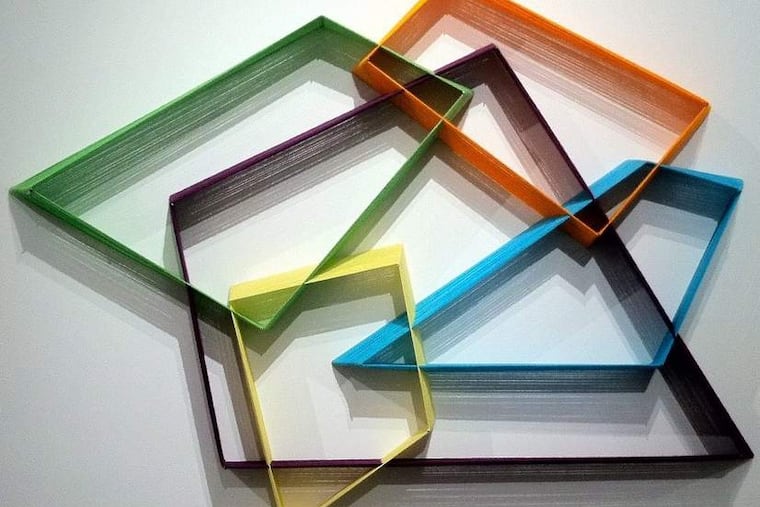Review: Unlike yet alike at LGTripp
The three artists who have solo shows at LGTripp Gallery have more in common than abstraction, but that is not immediately apparent because they use three different media — photography, paint, and yarn — and they occupy three entirely separate spaces (the installations of solo shows I've seen in the past here tend to overlap a little more than these three do). In fact, all three are exploring linear forms, strong contrasts of light and dark, and texture. Paul Rider's new series, "Drawn to the Light," comprises large, black-and-white, extremely close-up photographs of torn and molded paper shot from above. They could pass for close-up images of architecture, desert landscapes, or nude human figures, and the parallels between these and Edward Weston's photographs of dunes in the American West from the 1930s are clearly intentional.

The three artists who have solo shows at LGTripp Gallery have more in common than abstraction, but that is not immediately apparent because they use three different media — photography, paint, and yarn — and they occupy three entirely separate spaces (the installations of solo shows I've seen in the past here tend to overlap a little more than these three do). In fact, all three are exploring linear forms, strong contrasts of light and dark, and texture.
Paul Rider's new series, "Drawn to the Light," comprises large, black-and-white, extremely close-up photographs of torn and molded paper shot from above. They could pass for close-up images of architecture, desert landscapes, or nude human figures, and the parallels between these and Edward Weston's photographs of dunes in the American West from the 1930s are clearly intentional.
Rider's main influence, though, as he writes in his statement, was World War II photo-essayist W. Eugene Smith's 1946 picture The Walk to Paradise Garden, taken four years after Smith was wounded by a shell fragment in Okinawa and showing the photographer's two children walking hand-in-hand from the dark shade of a forest into a sunny clearing. Rider's images are easily imagined as abstractions of Smith's metaphor for the end of war.
An arrangement of Charles Kalick's colorful abstract paintings in what is arguably the most difficult space in the gallery — the long hallway that connects the front and back exhibition spaces — looks wonderful here in isolation against a crisp white wall. The bright yellows, blues, and pinks animating Kalick's compositions of rectangles pop out from the wall, and it's nice to be able to see his rich surface textures easily from the side as well as the front.
Using vividly hued yarn as his medium and long nails as supports, Ryan Pellak has woven assemblages of geometric shapes directly on the walls of the back gallery, each intersecting shape made up of multiple threads of one color of taut yarn. These quirky 3-D site-specific wall drawings even have Cousin Itt-like doppelgängers, identical companions that have been released and allowed to sag.
Precisely nowhere
Josette Urso's oil paintings on panels conjure things and places in her real life quickly and democratically jotted down, but without a there there. The mutable areas between her gestures, lines, and scaffolding-like shapes suggest the time, as much as the physical space, that lies in between each observance.
I like Urso's paintings that come closest to expressing a single moment and locale, such as her tiny City July 4th, a taupe-and-gray-dominated painting that captures a typically hazy summer evening in New York, and Yaddo Pale Green, its Arcadian opposite.
Art on the edges
Rachael Gorchov and Caroline Santa, both artists themselves, decided to organize a group show on a theme they knew well, the inefficiency of the art-making process, and what they term the "messy edges" of the studio, that place of experimentation where things are made that do not necessarily relate to the real work at hand but keep the creative juices flowing.
The result is "Intramural," the venue is Tiger Strikes Asteroid, and the artists whose playful doodlings were chosen include Frank Bramblett, Natalie Campbell & Heidi Neilson, Keith Crowley, Angela Dufresne, Julian Kreimer, MP Landis, Kele McComsey, Jackie Shatz and John Morton, and Christopher Ulivo.
The pieces that resonated the "messy edges" loudest and clearest for me were Landis' id12.007, a piece of paper that Landis must have been using as a blotter while making other works, complete with rings of paint left by jars and cans and penciled notes to himself, all of it to an unwittingly Twomblyesque effect; Ulivo's shadow puppets and scenery from The Day the Clown Cried; and painter Bramblett's How to Draw a Pig, autobiographical stories that suggest the possibility of a second career.